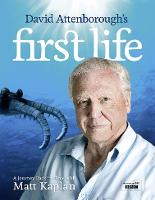


|
|
| book details |
David Attenborough’s First Life: A Journey Back in Time with Matt Kaplan
Introduction by Sir David Attenborough, By (author) Matt Kaplan

|
This book is currently unavailable. Enquire to check if we can source a used copy
|
| book description |
The epic story of the beginning of life on Earth from the much loved and respected naturalist, writer and broadcaster, Sir David Attenborough. Spanning billions of years, Attenborough's time-travelling narrative brings the reader face to face with the first animals that ever existed. By using the latest technology, we are finally able to see for ourselves how these early animals would have looked like and how they would have lived. Attenborough also shows us how some of the evolutionary features of these most primitive creatures are alive today in modern animals, including us humans. Attenborough shows us how the evolution of the first eyes, the first solid body parts and the first feet and backbones came to be. Looking at global ice ages and volcanic eruptions he also shows how evolution is heavily connected with the history of the planet. In this groundbreaking investigation, Attenborough travels the world, from Canada to Australia and Morocco to unearth the secrets hidden in prehistoric fossils, providing a deeper understanding of the first living creatures and the origins of our evolutionary traits.
| product details |
Normally shipped |
Publisher | HarperCollins Publishers
Published date | 29 Nov 2010
Language |
Format | Digital download
Pages | 288
Dimensions | 0 x 0 x 0mm (L x W x H)
Weight | 0g
ISBN | 978-0-0074-1205-1
Readership Age |
BISAC | nature / fossils
| other options |
|
|
|
To view the items in your trolley please sign in.
| sign in |
|
|
|
| specials |
|
|
|
Let's stare the future down and, instead of fearing AI, become solutionists.
|
This first comprehensive biography of Cecil Rhodes in a generation illuminates Rhodes’s vision for the expansion of imperialism in southern Africa, connecting politics and industry to internal development, and examines how this fueled a lasting, white-dominated colonial society.
|
|
|
|